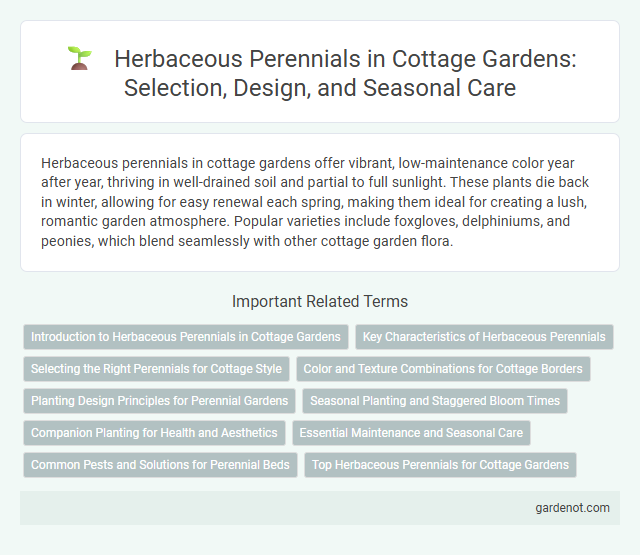Herbaceous perennials in cottage gardens offer vibrant, low-maintenance color year after year, thriving in well-drained soil and partial to full sunlight. These plants die back in winter, allowing for easy renewal each spring, making them ideal for creating a lush, romantic garden atmosphere. Popular varieties include foxgloves, delphiniums, and peonies, which blend seamlessly with other cottage garden flora.
Introduction to Herbaceous Perennials in Cottage Gardens
Herbaceous perennials are essential elements in cottage gardens, offering vibrant seasonal blooms and lush foliage that return year after year without woody stems. These plants thrive in informal settings, blending seamlessly with roses, climbers, and annuals to create the timeless, relaxed aesthetic characteristic of cottage gardens. Popular varieties include lavender, foxgloves, and delphiniums, valued for their resilience and ability to enhance biodiversity in garden ecosystems.
Key Characteristics of Herbaceous Perennials
Herbaceous perennials are non-woody plants that die back to the ground each winter and regrow from their roots in spring. They often feature lush foliage and vibrant flowers, providing long-lasting color and texture to cottage gardens through multiple seasons. Their adaptability to various soil types and resilience to pruning make them ideal for creating natural, informal garden designs.
Selecting the Right Perennials for Cottage Style
Selecting the right herbaceous perennials for a cottage garden involves prioritizing plants known for their lush foliage and abundant, long-lasting blooms, such as lupines, foxgloves, and delphiniums. These perennials thrive in well-drained soil with partial to full sun exposure, creating a dense, naturalistic planting that supports pollinators and enhances seasonal color. Emphasizing native and heirloom varieties ensures the garden maintains an authentic, low-maintenance charm consistent with traditional cottage aesthetics.
Color and Texture Combinations for Cottage Borders
Herbaceous perennials in cottage gardens create vibrant color and texture contrasts that enhance the charm of cottage borders. Combining soft, feathery plants like ferns with bold, colorful blooms such as delphiniums or hollyhocks adds depth and visual interest. Layering varied leaf shapes and flower hues creates a dynamic, natural look characteristic of traditional cottage garden aesthetics.
Planting Design Principles for Perennial Gardens
Herbaceous perennials thrive in cottage garden planting designs by providing year-round structure and seasonal interest through layered textures and varied bloom times. Incorporating a diverse mix of complementary species enhances biodiversity and resilience, while careful spacing ensures optimal air circulation to prevent disease. Selecting plants with overlapping flowering periods and integrating foliage contrast supports continuous visual appeal and ecological balance in perennial garden layouts.
Seasonal Planting and Staggered Bloom Times
Herbaceous perennials in cottage gardens enhance seasonal interest through staggered bloom times, providing continuous color from spring to autumn. Selecting varieties like delphiniums, peonies, and asters ensures successive flowering phases that attract pollinators and support biodiversity. Strategic planting schedules optimize growth cycles and extend visual appeal across multiple seasons without replanting.
Companion Planting for Health and Aesthetics
Herbaceous perennials such as echinacea, lavender, and yarrow enhance cottage gardens through strategic companion planting that promotes plant health and biodiversity. These perennials attract beneficial insects like bees and ladybugs, naturally reducing pests and improving pollination for vibrant blooms. Pairing them with complementary species such as rudbeckia and salvia creates layered textures and prolonged flowering seasons, enriching both aesthetics and ecological balance.
Essential Maintenance and Seasonal Care
Herbaceous perennials in cottage gardens require regular pruning and deadheading to promote vigorous growth and continuous flowering throughout the seasons. Mulching in early spring conserves soil moisture and suppresses weeds, while dividing clumps every 3-4 years ensures plant health and prevents overcrowding. Monitoring for pests and diseases during wetter months helps maintain vibrant, disease-free foliage essential for the garden's lush, natural aesthetic.
Common Pests and Solutions for Perennial Beds
Herbaceous perennials in cottage gardens often attract common pests such as aphids, slugs, and spider mites, which can damage leaves and stunt plant growth. Effective pest control solutions include introducing natural predators like ladybugs, applying neem oil, and using organic slug traps to maintain a healthy perennial bed. Regular monitoring and proper garden hygiene also reduce pest infestations, preserving the vibrant aesthetics of perennial plants.
Top Herbaceous Perennials for Cottage Gardens
Top herbaceous perennials for cottage gardens include lavender, echinacea, and phlox, known for their vibrant blooms and ability to attract pollinators. These plants thrive in well-drained soil and full sun, providing continuous color from spring through fall. Incorporating hostas and daylilies enhances texture and depth, creating a lush, naturalistic garden setting.
Herbaceous perennial Infographic

 gardenot.com
gardenot.com